Elevate your burger game with this delicious, homemade hamburger buns! These brioche-like buns are light in texture and high in flavour.
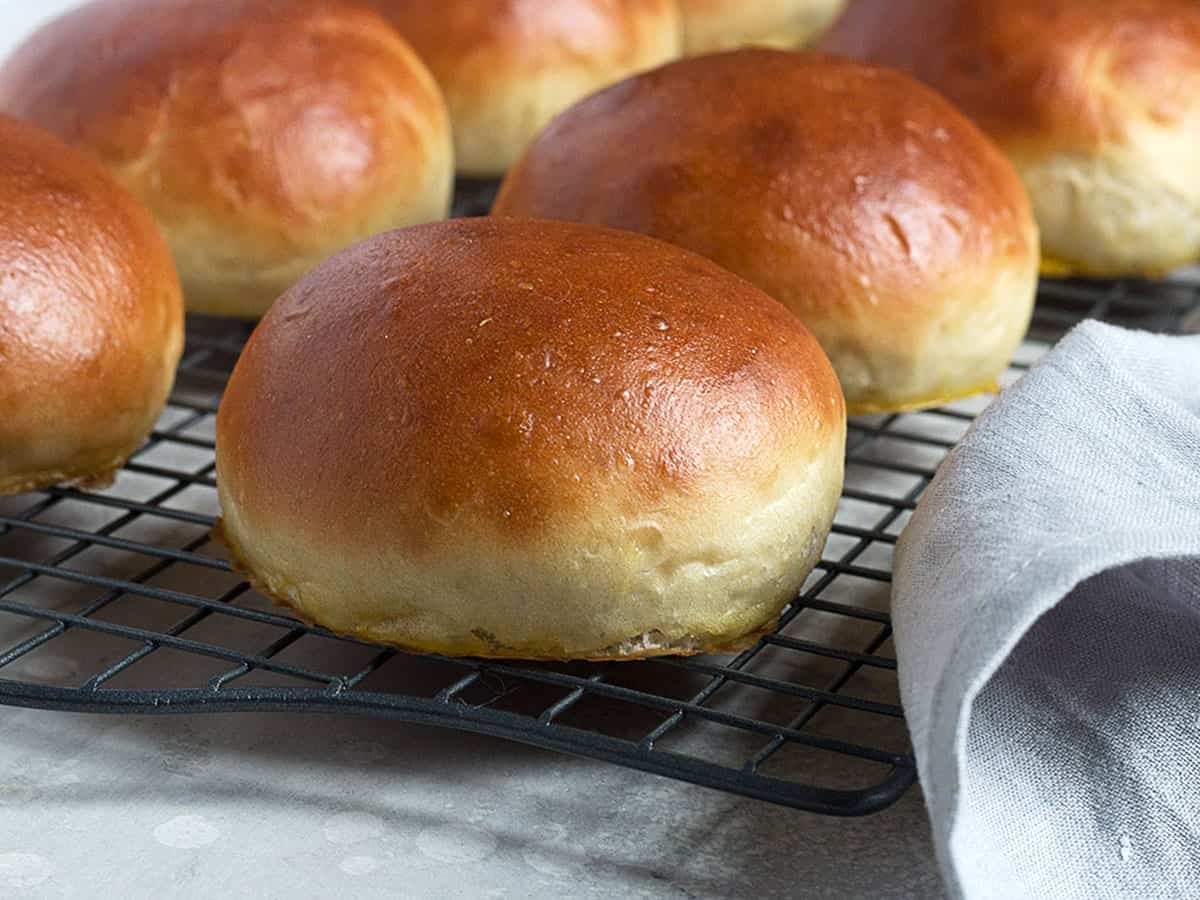
This is the only hamburger buns recipe I’ve used to make hamburger buns for years! While these buns are enriched with eggs and a bit of butter for flavour, they somehow still manage to be light in texture, yet sturdy enough to hold all the burger and the toppings.
So if you’re looking to elevate your burger game this Summer, these delicious homemade hamburger buns are a great place to start. They freeze beautifully, so make a couple of batches and load up the freezer and you’re always ready for a leisurely Summer BBQ
Ingredients and substitutions
A few notes about the key ingredients …
Bread flour – You’ll get the best results if you start with bread flour and even better, if you start with unbleached bread flour. Here in Canada, that’s not the easiest to find on the shelf in grocery stores. I get mine at Bulk Barn. Failing that, bleached bread flour is fine. You can use just all-purpose, but your buns might not rise quite as high.
Active Dry or Regular Instant Yeast – Active dry yeast needs to be proofed (soaked) in warm water before using. I never use dry active yeast myself, but prefer to use Instant Yeast (such as SAF Brand). While Instant Yeast doesn’t require proofing in water before using, it doesn’t hurt if you do, so I just go ahead and proof the Instant Yeast in the same manner as described in the recipe.
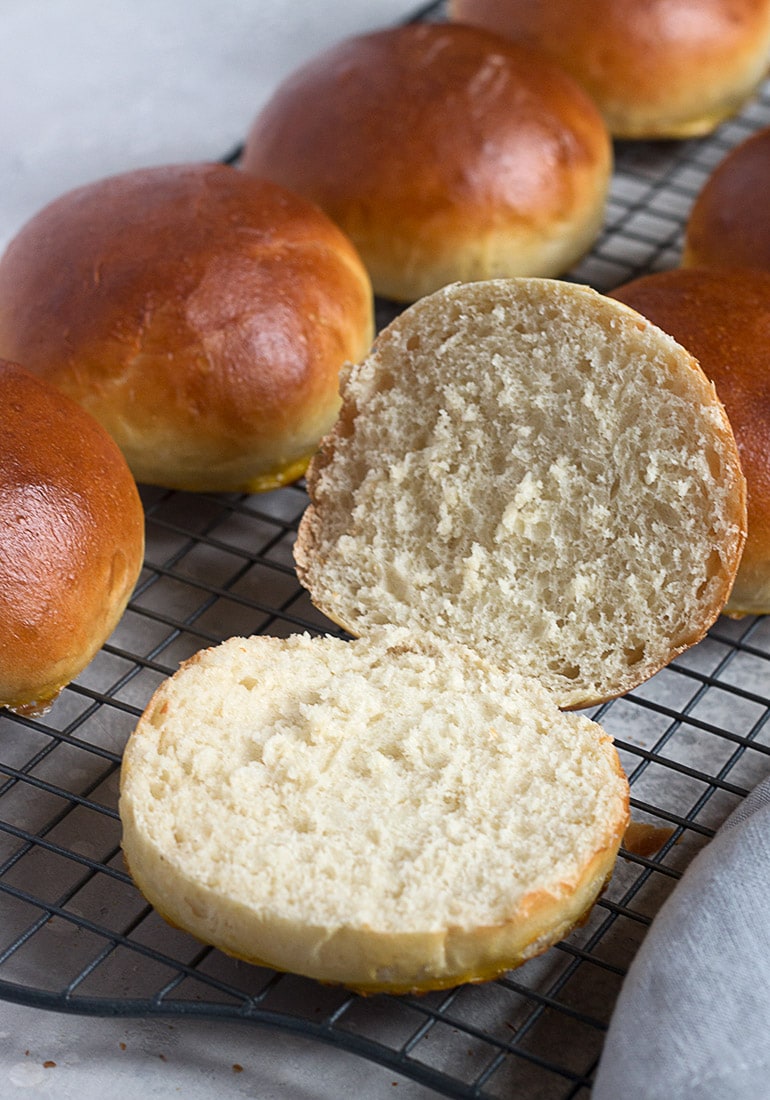
How to shape hamburger buns
I think the one thing that tends to trip people up when making buns is the shaping of “the ball”. It’s quite understandable that someone might think that you just need to grab a piece of dough and form/squeeze it into a ball shape. In fact though, there is a bit of a technique to creating “a ball” with dough, that creates what’s known as surface tension or tightness on the top of the ball. It’s this tension that encourages the dough to rise higher, while also creating a lovely smooth top.
The technique for forming the dough into buns is shown in this video. It’s the easiest way I think and produces great results.
1. Stretch the top to create a smooth top.
2. Flip over and stretch the sides in towards the centre and pinch together.
3. Do this all around the edges, until the sides are smooth, too.
4. Flip the ball over, so your pinched part is down.
Recipe video
Recipe Tip!
- The first thing you need to know about this dough is that it is very moist and almost sticky when made as prescribed. To get the best (lightest) results, you want to avoid as best you can adding much more flour here. Add just the bare minimum you need to, so you can handle the dough.
- This dough is also a slow riser, so be patient and allow it to rise for however long it takes to double etc. In a warm Summer kitchen, it will probably rise a little more quickly.
- I like to weigh the whole dough before dividing into balls. I then divide the total weight by 8, to calculate the dough weight of each roll. Weigh them out separately and you will have 8 identically sized rolls!
- Right after egg washing the buns and just before popping them in the oven, top buns with sesame seeds, poppy seed or “everything” mix if you’d like to add some toppings to your homemade buns.
Top tip!
Be sure to brush the egg wash on the dough evenly and thoroughly, being sure to get all around the bun and right to the bottom. Any bare spots left from your brushing will leave pale spots on the finished burger buns.
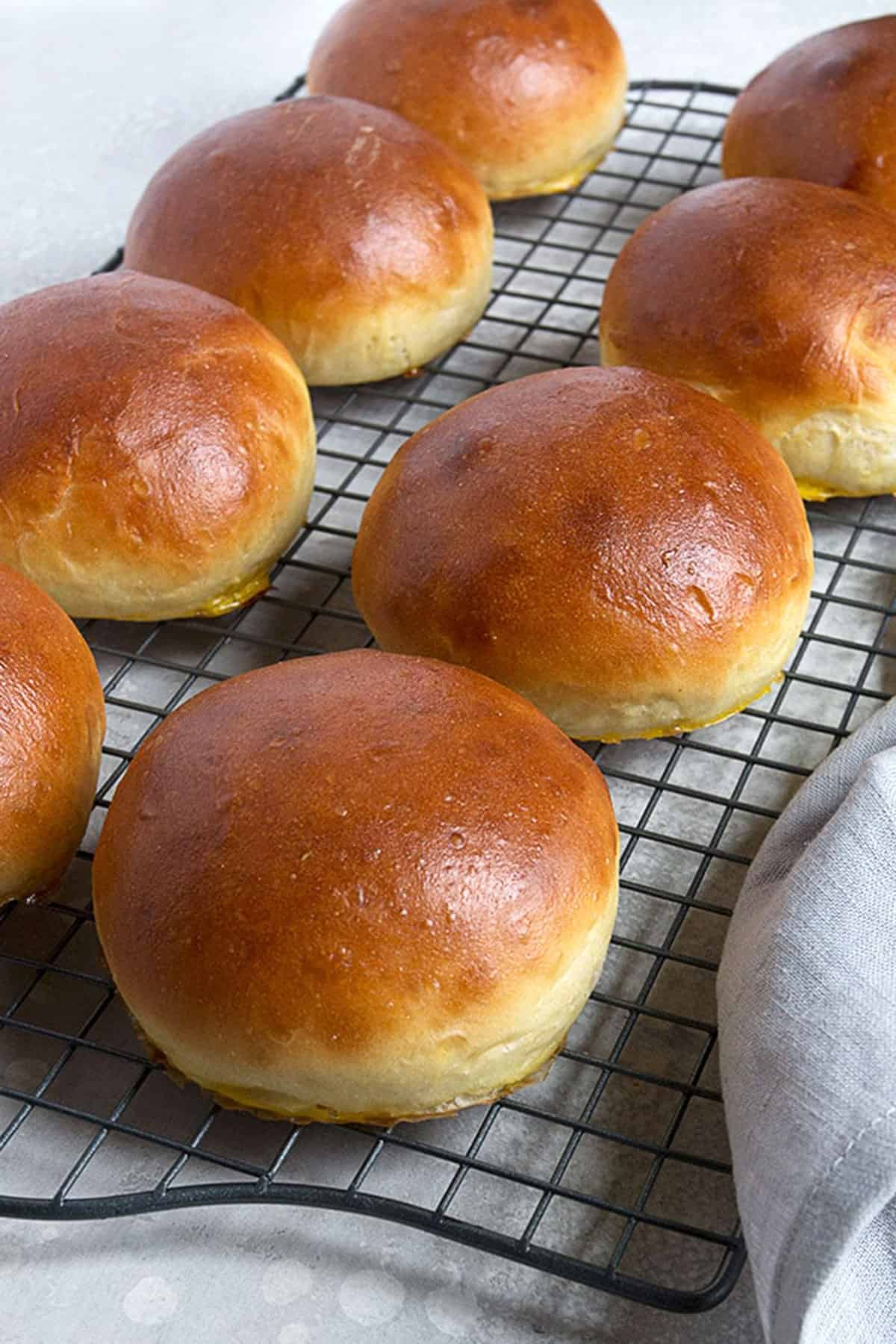
Making ahead, storing and freezing
These are best enjoyed on the day they are made, but it is perfectly fine to make in the morning and enjoy for dinner.
Store rolls in an airtight container, until needed, up to 24 hours. Freeze for longer storage.
These buns freeze beautifully up to 2 months! Simply remove the buns from the freezer and thaw on the counter. It will only take a short time to thaw (30 minutes, or so).
Want to save this recipe?
Enter your email and I’ll send it to your inbox. Plus, you’ll get great new recipes from me every week!
By submitting this form, you consent to receive emails from Seasons and Suppers.
You can unsubscribe at any time.
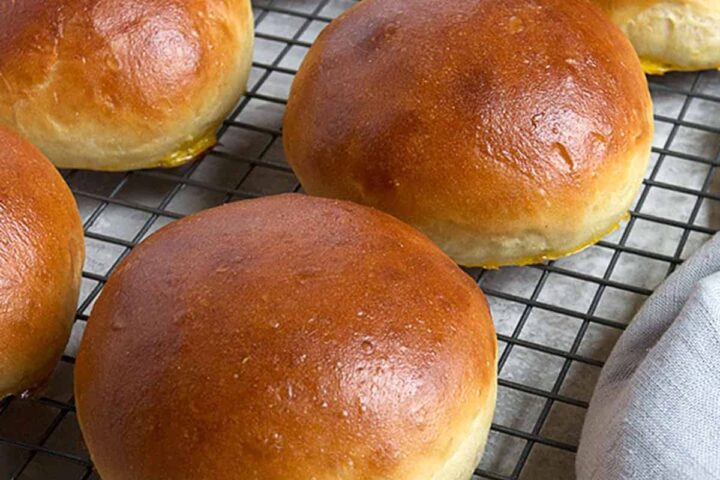
Get the Recipe: Simply Perfect Homemade Hamburger Buns
Ingredients
- 1 cup (240 g) water, warmed to about 105-110F
- 3 Tablespoons (45 g) milk, warmed slightly to lukewarm
- 2 teaspoons (6 g) active dry yeast or regular Instant yeast, not quick or rapid rise yeast
- 2 1/2 Tablespoons (33 g) white sugar
- 1 large egg, beaten with a fork
- 3 cups (375 g) bread flour, spooned and levelled
- 1/3 cup (45 g) all-purpose flour, spooned and levelled
- 1 1/2 teaspoons (9 g) fine salt
- 2 1/2 Tablespoons (35 g) unsalted butter, at room temperature
For egg wash:
- 1 large egg
- 1 Tablespoon water
- Poppy or sesame seeds, optional
Instructions
- Before you start! Scroll down to the Recipe Notes for some important tips on working with sticky dough.
- In a small bowl or 2 cup measuring cup, combine the warm water, warmed milk, yeast and sugar. Let stand until bubbly, about 5 minutes.
- In a large bowl, whisk together the bread flour, all purpose flour and salt. Add the butter. Using your finger tips, rub the butter in to the flour mixture, making even crumbs.
- Add the yeast mixture and the beaten egg to the bowl and using a dough scraper or silicone spatula, stir until a moist, sticky dough forms.
- Using a silicone bowl scraper, scrape the dough on to a very lightly floured counter or work surface. At this point the dough is very moist and sticky and not really able to be kneaded as you traditionally would. You will be tempted to dust with flour, but resist the urge to start. Instead of traditionally kneading, use your dough scraper or silicone spatula to scoop up the dough and then slam it back on the counter. (Don't just drop it, slam it. It's therapeutic :) Use your scraper to turn it over a few times on the counter, then pick it up and slam it again. Repeat this slaming/turning action for a couple of minutes. You should find that it is a sticking to the counter a little less. If you feel it isn't progressing after a couple of minutes (is still super sticky), very lightly dust the counter with flour and turn the dough over it to flour very lightly (Not too much flour. Just a dusting). Continue doing the slam and turn action for several more minutes. At some point, after about 5 minutes or so of this routine, your dough should stop sticking to the counter. Though it will still be a quite moist dough, you should be able to form it into a ball. *If your dough is still sticking after 5-7 minutes of working it, dust with a tiny bit more flour, as needed, until it is no longer sticking, but is still nice and moist.
- Shape dough into a ball and place into a greased bowl. Cover with plastic wrap and let rise until doubled, 1-2 hours. Note that this dough is a bit of a slow-riser. Allow it to rise until doubled, no matter how long that takes.
- Line a large baking sheet with parchment paper and set aside.
- Using a dough scraper, divide the dough into 8 equal pieces. (* I like to weight the dough ball and then divide that weight by 8, to get a weight for each piece. I then weigh out each piece to that weight, to get 8 exactly equal pieces. My last bake, the individual balls were 101g apiece. Yours may vary somewhat.)
- If your dough is still too sticky at this point to form into balls, very lightly dust with a tiny bit of four.
- Form each of the 8 dough pieces into balls (* See video above the recipe card on how to do this!). Place balls on parchment lined baking sheet about 2-3 inches apart. Cover loosely with a clean kitchen towel and let rise until doubled again, 1-2 hours.
- Set a large shallow roasting pan of water on the lowest rack of the oven. Preheat oven to 400F (not fan assisted) with a rack in centre of the oven, as well.
- When buns have doubled, beat remaining egg with 1 tablespoon water and brush the buns thoroughly. * Be sure to brush the entire bun, top and sides, right down to the pan, as any areas you miss will be pale-coloured once baked. If desired, you could sprinkle with sesame or poppy seeds at this point, as well. Bake, turning sheet 180 degrees halfway through baking, until tops are golden brown, about 15 minutes.
- Immediately transfer buns to a rack to cool completely.
Notes
More bun recipes to love!
Hi! I’m Jennifer, a home cook schooled by trial and error and almost 40 years of getting dinner on the table! I love to share my favourite recipes, both old and new, together with lots of tips and tricks to hopefully help make your home cooking enjoyable, stress free, rewarding and of course, delicious!


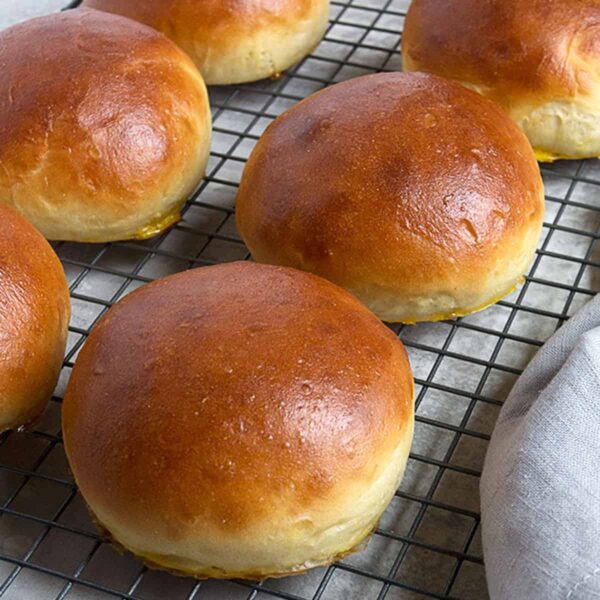
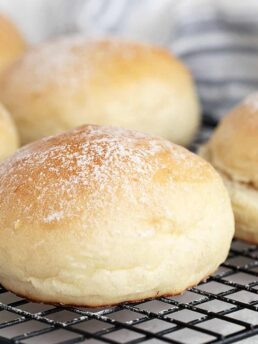
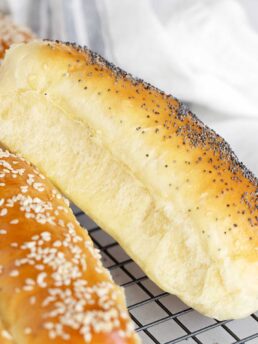
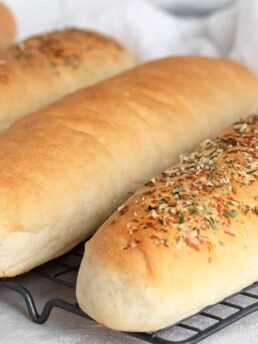

This is my go to recipe for burger buns – the best! 💯
I put all the ingredients into my bread maker and use the dough setting and it works perfectly.I check it in the first 15 minutes to make sure the dough is the right consistency and adjust if necessary.
Thanks for sharing it!!
Thanks so much, Bess :)
I doubled the recipe. I put it all in my bread maker on the dough setting. I took it out and shaped 16 buns, let them rise again, and baked as directed. They were fantastic!!! We had them with hamburgers and the rest got eaten as dinner rolls or pb and j! They are a huge hit, thank you!
I’m so glad you enjoyed them, Jackie! Thanks so much :)
I meant to leave a review the first time I made these wonderful easy hamburger buns. I was making sloppy joes and didn’t have buns. I had just made my first loaf of bread so I thought I’d try making buns. They turned out great, soft yet firm. My husband said that it was the best hamburger bun he’s had. I’m making them again now. Thanks so much for the recipe.
So glad you are enjoying them, Tina! Thanks so much :)
Made this tonight for the first time and they turned out GREAT!! This will now be my go-to recipe for hamburger buns. I’m excited to try other recipes on this site.
So pleased to hear! Thanks so much :)
In a word…WOW! These were AMAZING! So delicious and yet held up well under my very juicy burgers! Just having been given a flour mill, I milled my own flour and then used that flour (made from hard wheat berries) as directed for this recipe. These were HUGE hamburger buns. Next time I will make 12 or more buns from this recipe. We usually eat 4 oz burgers. Though these were large, they were so very tasty and I did not brush with egg or milk wash, yet they were beautifully browned and so soft and fluffy inside. Yep – this is my new “go to”.
So glad to hear! Thanks so much :)
Delicious and simple
Thanks so much, Sandra!
Hi, i’m not entirely sure if I understood the oven part correct since English isn’t my first language. But is it correct that you put a baking tray filled with water inside the oven? And above that a rack + baking sheet with the buns? Hope to hear from you soon! Hope to make them today :) thanks !
Hi Anne and yes, the tray with the water should be on a rack lower than the buns. Enjoy!
Insanely good recipe! I opted for laziness and used a food processor to work in the butter, and a stand mixer to work the dough. They turned out great on my first try.
So glad to hear, Laura. Thanks so much!
Giving this recipe 5 stars because it’s for real and works! Buns are currently on the cooling rack and smell fantastic! Waiting for Papa to come in from work and he’ll enjoy them with pulled pork and fried potatoes ☺ Happiest New Year to you!!
Thanks so much Lila and to you, as well! So glad you enjoyed them :)
I wish I could post the picture, they just came out of the oven and look and smell amazing! Thanks for posting this recipe.
Thanks Melanie! So pleased to hear :)
Sorry if you posted this and I did not see it, but can these be frozen?
Hi Elaine and yes, these freeze beautifully! In fact, I will freeze them if I won’t be using them within a day, as freezing preserves the freshness really well.
Hi Jennifer
Nice & simple recipe. The only thing I do differently is add the yeast to the dry ingredients and beat the egg and melted butter together with the milk and water. It’s a little easier than cutting the butter into the flour. Also for those who don’t want to reserve egg or use an additional egg for an egg wash you can simply brush milk over the buns. They will brown nicely and allow seeds to stick to the top.
So glad you are enjoying these buns, Howard. Thanks so much!
I don’t brush the tops, but I love this recipe. They last a couple of weeks in the fridge.
So glad you are enjoying them, Kristin! Thanks so much :)
Made these buns again and they turned out delicious!!!!😋
So glad to hear, Lori :) Thanks!
Rarely do I bake anything that remotely resembles the picture…till now! By far the best buns I have ever had, and this was my first, but not my last, attempt. I resisted the urge to knead the dough and did your “slamming” technique, which I see where it could be very therapeutic! A keeper recipe and one I know I will make regularly! Love it!
I’m am so pleased to hear, Pat :) Thanks so much!